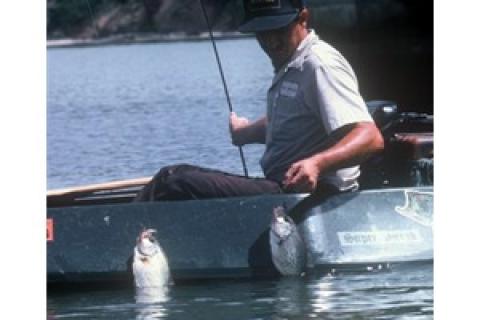
 One of the hardest things anglers face as winter begins to loosen its grip on the land is what species to go after. March through April is a prime time for many gamefish, from bass to bluegills, catfish to trout. One of my favorite quarries, though, for later winter-early spring fishing trip is the crappie.
One of the hardest things anglers face as winter begins to loosen its grip on the land is what species to go after. March through April is a prime time for many gamefish, from bass to bluegills, catfish to trout. One of my favorite quarries, though, for later winter-early spring fishing trip is the crappie.
It's no wonder that crappies are among the country's most popular gamefish. Whether you find mostly the black species, the paler-hued whites, or a mixture of the two, they are intriguing to seek out as waters first start to warm up after the long, cold winter. The fish are full of spunk and fight now, and the flesh is firm and delectable when broiled, deep-fried or lightly sauteed in lemon and butter.
You can catch crappies in small ponds, natural lakes and big, deep-water impoundments. Slow-flowing rivers may also hold good populations. Check with local wardens and your state fishery department for the best bets close to your home.
For the next few weeks, in most of the country, the best way to catch crappies will be drifting in deep water staging areas where the fish congregate before moving in tight to shore to spawn near docks, blowdowns and submerged brush piles. Work depths of 6 to 18 feet, with small jigs or minnows hooked through the lips or back when water temperatures are in the upper 40s to low 50s.
The tight-lining system with a bell shaped fishing sinkers on the bottom and two fishing jigs for panfish or minnows on droppers works especially well. Jigs can be marabou or soft plastic grub types in white, yellow, chartreuse and shad colors.
Bridge pilings are good spots to try, as are drop-offs, channel edges and the juncture where creek arms meet the main river.
Try drifting if the wind is blowing at a light to moderate pace. If it's calm or too strong, use the electric motor to ease slowly along over likely areas. Once you hook a fish, keep probing that area, since crappies will usually be tightly schooled at this time of year. You can try anchoring where you catch one, but sometimes it's more productive to simply re-drift through the area repeatedly.
As the sun bakes the shallows into the mid to upper 50s, crappies will move tight to shore to spawn. Now the real fun begins. (And this is already happening in the Deep South.) The fish will be found around docks, beaver huts, log jams, flooded timber and brush piles in depths of 2-6 feet. Darker colored males move in first, but within days the paler, egg-laden females follow.
In clean lakes with limited cover, casting with spin tackle and jigs is a great way to find roving schools of fish. Use 4-6 pound fishing line and 1/16 to 1/8 ounce marabou jigs or lead heads with a soft plastic dressing. Cast out, let the lure descend 3 to 6 feet, and then slowly reel back. Pause now and then to let the jig suddenly drop deeper. Often fish will nail the lure at this point as it flutters down like a wounded baitfish.
Another option for catching shallow water crappies is to use a bobber or float and minnow rig, fished with a cane pole or fly fishing rod. Use the long rod to flip the offering into pockets of open water amid the flooded brush and next to dock pilings.
A final tactic calls for using the same rig but with a jig instead of a minnow. Skip the bobber and simply swim the jig in and around any brush or flooded trees you can find with the fly rod or cane pole. Don't pump it. Simply move it slowly around the cover. When you feel a tap or sudden weight, set the hook.
Then you'll have the start of the ingredients for a delicious fish fry — the ultimate reward for a spring day spent searching for this intriguing black and white speckled quarry.
- 3426 views

